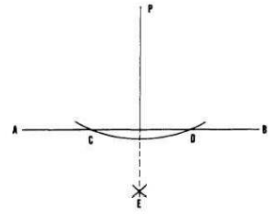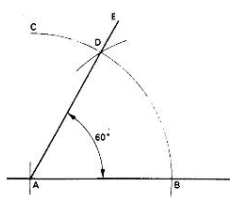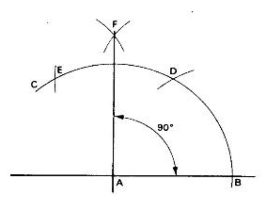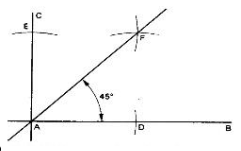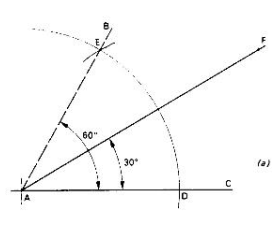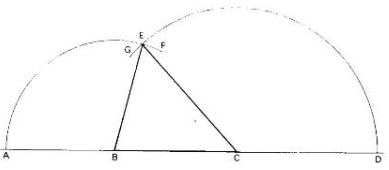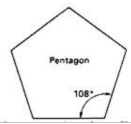- Construction Instruments
- Construction of Perpendicular Lines
- Construction of Angles using a Ruler and a Pair of Compass Only
- Construction of Parallel Lines
- Proportional Division of lines
- Construction of Regular Polygons
- Construction of Irregular Polygons
- Past KCSE Questions on the Topic

Construction Instruments
The following minimum set of instruments is required in order to construct good quality drawings:
- Two set squares.
- A protractor.
- A 15 cm or 150 mm ruler
- Compass
- Protractor
- Divider
- An eraser/rubber
- Two pencils - a 2H and an HB, together with some sharpening device – Razor blade or shaper.

Construction of Perpendicular Lines
To obtain the perpendicular bisector PQ
The figure below shows PQ as a perpendicular bisector of a given line AB.
- With A and B as centre, and using the same radius,draw arcs on either side of AB to intersect at P and Q.
- Join P to Q.
To construct a perpendicular line from a point
The figure below shows PE, a perpendicular from a point P to a given line AB.
- To drop a perpendicular line from point P to AB.
- Set the compass point at P and strike an arc intersecting AB at C and D.
- With C and D as centres and any radius larger than one-half of CD,
- Strike arcs intersecting at E.
- A line from P through E is perpendicular to AB.
To construct a perpendicular line from a point
- Using P as centre and any convenient radius,draw arcs to intersect the lines at A and B.
- Using A as centre and a radius whose measure is greater than AP,draw an arc above the line.
- Using B as the centre and the same radius,draw an arc to interact the one in (ii) at point Q.
- Using a ruler ,draw PQ.
Construction of perpendicular lines using a set square.
- Two edges of a set square are perpendicular.
- They can be used to draw perpendicular lines.
- When one of the edges is put along a line, a line drawn along the other one is perpendicular to the given line.
To construct a perpendicular from a point p to a line
- Place a ruler along the line.
- Place one of the edges of a set square which form a right angle along the ruler.
- Slide the set square along the ruler until the other edge reaches p.
- Hold the set square firmly and draw the line through P to meet the line perpendicularly.

Construction of Angles Using a Ruler and a Pair of Compass Only
The basic angle from which all the others can be derived from is the 600, 450 and 900
Construction of an Angle of 600
- Let A be the apex of the angle
- With centre A draw an arc BC using a suitable radius.
- With b as the centre draw another arc to intersect arc BC at D.
- Draw a line AE through D. The angle EAC is 600
Construction of an Angle of 900
- Let A be the apex of the angle.
- With centre A draw an arc BC of large radius.
- Draw an arc on BC using a suitable radius and mark it D.
- Using the same radius and point D as the centre draw an arc E.
- BD and DE are of the same radius.
- With centre D draw any arc F.
- With centre E draw an arc equal in radius to DF.
- Join AF with a straight line. Angle BAF is 900
Construction of an Angle of 450
- Draw AB and AC at right angles 450 to each other.With centre A and with large radius ,draw an arc to cut AB at D and and AC at E.
- With centres E and D draw arcs of equal radius to intersect at Draw a straight line from A through Angle BAF is 450
Construction of Angles of Multiple of 7½o, 300, 150
The bisection of 600 angle produces 300 and the successive bisection of this angle produces 150 which is bisected to produce 7½o as shown below
- Draw AB and AC at 600 to each other as shown above.
- With centre A, and a large radius, draw an arc to cut AB at E and AC at D.
- With centres E and D draw arcs of equal radius to intersect at F.
- Draw a line from A through F.
- Angle CAF is 300 half 600.
To Construct 150, 7½o
- Draw AC and AF at 300 to each other as described above.
- With centres G and D draw arcs of equal radius to intersect at H
- Draw a line from A through H
- Angle CAH is 150.
- With centres J and D a further bisection can be made to give 7½0

Construction of Parallel Lines
- To construct a line through a given point and parallel to a given line, we may use a ruler and a pair of compass only, or a ruler and a set square.
Using a Ruler and A Pair of Compass Only
Parallelogram method
The line EP parallel to AC is constructed as follows:
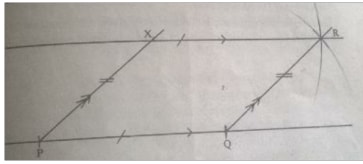
- With X as the centre and radius PQ, draw an arc.
- With Q as the centre and radius PX, draw another arc to cut the first arc at R.
- Join X to R.

Proportional Division of Lines
Lines can be proportionately divided into a given number of equal parts by use of parallel lines.
To divide line AB
- Divide line AB into ten equal parts.
- Through b, draw a line CB of any convenient length at a suitable angle with AB.
- Using a pair of compasses, mark off,along BC ,ten equal intervals as shown above.
- Join C to A.By using a set square and a ruler, draw lines parallel to CA.
- The line is therefore divided ten equal parts or intervals.

Construction of Regular Polygons
A polygon is regular if all its sides and angles are equal ,otherwise it is irregular.
Note:
- For a polygon of n sides,the sum of interior angles is ( 2n − 4 ) right angles.The size of each interior angle of the regular polygon is therefore equal to ((2n−4)/n) × 90o .
- The sum of exterior angles of any polygon is 3600.Each exterior angle of a regular polygon is therefore equal to 360/n.
Construction of a Regular Triangle
- Draw AB, BC and CD equal in length to the sides of the required triangle
- With centre B and aradius AB draw the arc AF
- With centre C and radius CD draw the arc DG
- Where the arcs intersect at E is an apex of the triangle
- Join BE and CE with straight lines to form the triangle BCE
Construction of a Regular Quadrilateral
- Mark off one side of the square AB on the base line
- With centre A and radius AB draw the arc BC
- With centre B and radius AB draw the arc CD
- With centre E and radius AB step off F and G on arcs BC and AD respectively
- With centres E and F draw arcs of equal radius to intersect at H
- With centres E and G draw arcs of equal radius to intersect at J
- Erect perpendicular AH and BJ
- The arcs BC and AD cut the perpendiculars AH and BJ at K and L respectively
- To complete the square join K and L
Construction of a Regular Pentagon.
To construct a regular pentagon ABCD of sides 4 cm.
Each of the interior angles = ((10−4)/5) × 90 right angles = 1080
- Draw a line AB = 4 cm long.
- Draw angle ABC = 1080 and BC =4 cm
- Use the same method to locate points D and E

Note;
- Use the same procedure to construct other points.

Construction of Irregular Polygons
Construction of Triangles
To construct a triangle given the length of its sides
- Draw a line and mark a point A on it.
- On the line mark off with a pair of compass a point B, 3 cm from A.
- With B as the centre and radius 5 cm, draw an arc
- With A as the centre and radius 7 cm,draw another arc to intersect the arc in (iii) at C.Join A to C and B to C.
To construct a triangle, given the size of two angles and length of one side.
Construct a triangle ABC in which ∠ BAC = 600, ∠ ABC = 500 and BC = 4 cm.The sketch is shown below.
- Draw a line and mark a point B on it.
- Mark off a point C on the line, 4 cm from B.
- Using a protractor, measure an angle of = 500 and = 700 at B and C respectively.
To construct a triangle given two sides and one angle.
Given the lengths of two sides and the size of the included angle. Construct a triangle ABC, in which AB = 4 cm,BC =5 cm and ∠ ABC =600.Draw a sketch as shown below.
- Draw a line BC = 5 cm along
- Measure an angle of = 600 at B and mark off a point A, 4 cm from B.
- Join A to C.

To Construct a Trapezium.
The construction of a trapezium ABCD with AB = 8 cm ,BC = 5 cm, CD = 4cm and angle ABC = 600 and AB = 8 cm
- Draw a line AB = 8 cm.
- Construct an Angle of = 600 at B.
- Using B as the centre and radius of 5 cm, mark an arc to insect the line in (ii) at C.
- Through C , draw a line parallel to AB
- Using C as the centre and radius of 4 cm,Mark an arc to intersect the line in (iv) at D.
- Join D to A to form the trapezium.

Past KCSE Questions on the Topic
- Using a ruler and a pair of compasses only,
- Construct a triangle ABC in which AB = 9cm, AC = 6cm and angle BAC = 37½0
- Drop a perpendicular from C to meet AB at D. Measure CD and hence find the area of the triangle ABC
- Point E divides BC in the ratio 2:3. Using a ruler and Set Square only, determine point E. Measure AE.
-
On the diagram, construct a circle to touch line AB at X and passes through the point C. (3 mks) - Using ruler and pair of compasses only for constructions in this question.
- Construct triangle ABC such that AB=AC=5.4cm and angle ABC=300. Measure BC (4 mks)
- On the diagram above, a point P is always on the same side of BC as A. Draw the locus of P such that angle BAC is twice angle BPC (2 mks)
- Drop a perpendicular from A to meet BC at D. Measure AD (2 mks)
- Determine the locus Q on the same side of BC as A such that the area of triangle BQC = 9.4cm2 (2 mks)
- Without using a protractor or set square, construct a triangle ABC in which AB = 4cm, BC = 6cm and ∠ABC = 67½0. Take AB as the base. (3mks)
Measure AC. - Draw a triangle A1B1C1 which is indirectly congruent to triangle ABC. (3mks)
- Without using a protractor or set square, construct a triangle ABC in which AB = 4cm, BC = 6cm and ∠ABC = 67½0. Take AB as the base. (3mks)
- Construct triangle ABC in which AB = 4.4 cm, BC = 6.4 cm and AC = 7.4 cm. Construct an escribed circle opposite angle ACB
- Measure the radius of the circle (5 mks)
- Measure the acute angle subtended at the centre of the circle by AB (1 mk)
- A point P moves such that it is always outside the circle but within triangle AOB, where O is the centre of the escribed circle. Show by shading the region within which P lies. (3mks)
- Using a ruler and a pair of compasses only, construct a parallelogram PQRS in which PQ = 8cm, QR = 6cm and PQR = 1500 (3 mks)
- Drop a perpendicular from S to meet PQ at B. Measure SB and hence calculate the area of the parallelogram. (5 mks)
- Mark a point A on BS produced such that the area of triangle APQ is equal to three quarters the area of the parallelogram (1 mk)
- Determine the height of the triangle (1mk)
- Using a ruler and a pair of compasses only, construct triangle ABC in which AB = 6cm, BC = 8cm and angle ABC = 45o. Drop a perpendicular from A to BC at M. Measure AM and AC (4mks)
- Using a ruler and a pair of compasses only to construct a trapezium ABCD such that AB = 12 cm, ∠DAB = 60o, ∠ABC = 75o, and AD = 7 cm (5 mks)
- From the point D drop a perpendicular to the line AB to meet the line at E. measure DE hence calculate the area of the trapezium (5 mks)
- Using a pair of compasses and ruler only;
- Construct triangle ABC such that AB = 8cm, BC = 6cm and angle ABC = 300.(3 marks)
- Measure the length of AC
- Draw a circle that touches the vertices A, B and C.
- Measure the radius of the circle
- Hence or otherwise, calculate the area of the circle outside the triangle.
- Using a ruler and a pair of compasses only, construct the locus of a point P such that angle APB = 600 on the line AB = 5cm. (4 mks)
- Using a set square, ruler and pair of compases divide the given line into 5 equal portions. (3mks)
- Using a ruler and a pair of compasses only, draw a parallelogram ABCD, such that angle DAB = 750. Length AB = 6.0cm and BC = 4.0cm from point D, drop a perpendicular to meet line AB at N
- Measure length DN
- Find the area of the parallelogram (10 mks)
- Using a ruler and a pair of compasses only, draw a parallelogram ABCD in which AB = 6cm, BC = 4cm and angle BAD = 60o. By construction, determine the perpendicular distance betweenthe lines AB and CD
- Without using a protractor, draw a triangle ABC where ∠CAB = 30o, AC = 3.5cm and AB = 6cm. measure BC
- Using a ruler and a pair of compass only, construct a triangle ABC in which angle ABC = 37.5o, BC =7cm and BA = 14cm
- Drop a perpendicular from A to BC produced and measure its height
- Use your height in (b) to find the area of the triangle ABC
- Use construction to find the radius of an inscribed circle of triangle ABC
- In this question use a pair of compasses and a ruler only
- Construct triangle PQR such that PQ = 6 cm, QR = 8 cm and ∠PQR = 135°
- Construct the height of triangle PQR in (a) above, taking QR as the base
- On the line AC shown below, point B lies above the line such that ∠BAC = 52.5o and AB = 4.2cm. (Use a ruler and a pair of compasses for this question)
- Construct ∠BAC and mark point B
- Drop a perpendicular from B to meet the line AC at point F . Measure BF
Download Geometric Constructions - Mathematics Form 1 Notes.
Tap Here to Download for 50/-
Get on WhatsApp for 50/-
Why download?
- ✔ To read offline at any time.
- ✔ To Print at your convenience
- ✔ Share Easily with Friends / Students


